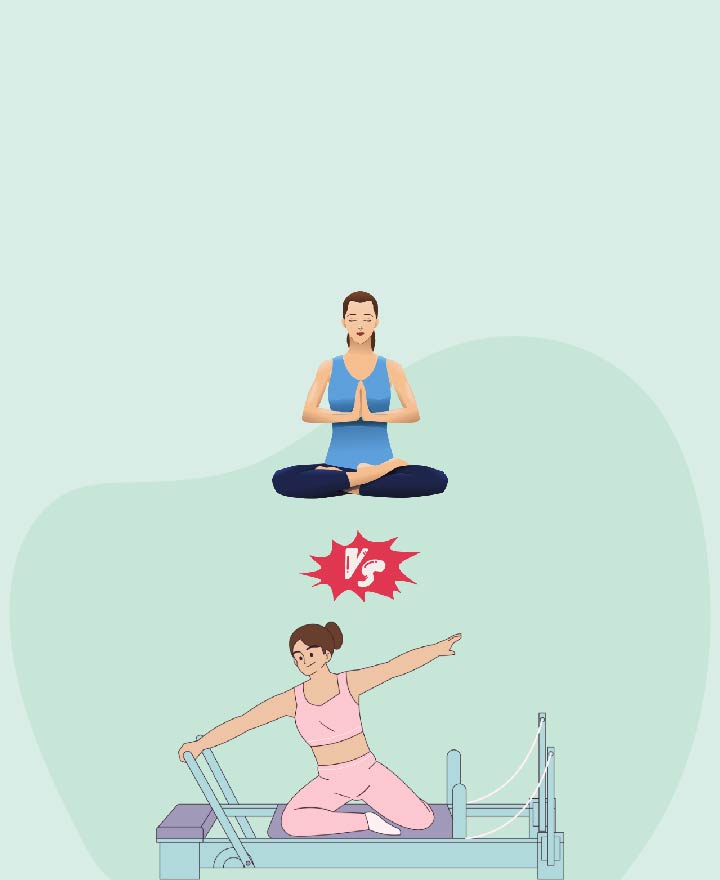

Pilates vs. Yoga: What’s the Better Workout?
Yoga and Pilates are both low-impact workouts that focus on using bodyweight resistance. They both seem to offer similar workouts, so how do you choose? Take a look at this article to know benefits, similarities, and differences of pilates vs yoga.
Pilates
Pilates has gained immense popularity in recent years and is one of the most popular choices adopted by many fitness enthusiasts. The name “Pilates” is derived from its creator, Joseph Pilates.
This workout method is a challenging low impact exercise method that balances strength with mobility, aligns the body, fine-tunes movement patterns, and strengthens the deeper muscles of the core.
Benefits of Pilates
● Increases core strength
● Improves body posture, balance & strengthens your bone
● Decreases back pain
● Prevents injuries and increases energy
● Decreases stress and boosts your mood
● Enhances body awareness and improves flexibility & mobility
● Reduces menstrual pain
● Boosts your immunity
● Improves cognitive functioning
● Improves sleep and encourages playfulness
Several studies also suggest that it can help individuals with health conditions like urinary incontinence, joint injuries, arthritis, back pain, etc.
Yoga
Yoga is an Art and Science of healthy living. It is a spiritual discipline which focuses on bringing harmony between mind and body. The holistic approach of Yoga is well established and it brings harmony in all walks of life and thus, known for disease prevention, promotion of health and management of many lifestyle –related disorders.
Benefits of Yoga
● Improves strength, balance, and flexibility
● Helps with back pain relief
● Heart health benefits
● Can ease arthritis symptoms
● Relaxes you to help you sleep better
● Helps relieve stress & reduce anxiety
● Promotes better self-care
Some studies suggest that yoga is also beneficial to individuals with health conditions like diabetes (type 2), high blood pressure, arthritis, anxiety, depression, chronic pain, respiratory conditions, etc.
Similarities between Pilates & Yoga
While Pilates and yoga are distinct practices, they have many things in common:
1. Both yoga and Pilates have physical and mental health benefits.
2. Both are low-impact workouts and gentle on the joints.
3. They both primarily use body weight to build strength.
4. Proper form is essential in each practice, so both are best done with trained instructors.
5. Once you have learned the form and technique, you can do both yoga and Pilates at home with limited or no equipment.
6. Both practices build core strength, improve posture and balance, and increase flexibility.
7. They both focus on breathing and require mental focus.
Key Differences between Pilates & Yoga
1. The Spiritual Focus
Yoga can provide spiritual element to your workout.
While Pilates includes a focus on breathing and connecting the mind and body, it is not a spiritual practice.
2. Variety
Yoga has variety of poses and you can choose from a gentle restorative class or a challenging, sweaty hot yoga session.
Pilates is generally a mat workout or reformer exercises with little variety in style.
3. Movements
Yoga has bigger movements and transitions.
Pilates has smaller movements which are more precise and it’s a slower form workout.
4. Rehabilitation
Pilates is good for rehabilitation from injuries or surgery. Unlike yoga, Pilates can be adapted to match each individual’s limitations and can help build strength slowly and safely.
5. Equipment
Some Yoga poses use basic props.
Few Pilates variations require more complicated equipment like the reformer and the Cadillac.
6. Core Strength
Yoga strengthens over-all body, but the focus is more on arms and legs.
Pilates focuses on developing core muscles, including the back, abs, hips and glutes.
Pilates vs Yoga: Which is better?
Yoga and Pilates are both great workouts.The decision of choosing between the two workouts depends on your goals and expectations.
If you want to increase strength and flexibility, Pilates might be a better choice. If you want to improve overall wellness, you might opt for yoga.
If you have a health condition, consult an instructor to determine what’s best for you.
Conclusion
Yoga and pilates are low-impact workouts with an emphasis on bodyweight resistance. Both forms of exercise focusses on all muscles rather than specific muscle groups and they are great additions to your weekly exercise routine.
One of the important components of our overall wellness is also being financially secured. Healthcare emergencies can happen any time, but a good health insurance can protect you from such uncertain situations. To know more about it, click here
Source: Healthline, WebMD
Disclaimer: This blog provides general information and discussions about health and related subjects. The information and other content provided in this blog, website or in any linked materials are not intended and should not be considered, or used as a substitute for, medical advice, diagnosis or treatment. Kindly contact your Doctor before starting a new medicine or health regime.
Related Articles
Iyengar Yoga and how is it beneficial
Meditation for Depression-Why it works
Mental Health – Overcoming the Stigma
Published on January 12, 2023

















 Health Insurance
Health Insurance  Travel Insurance
Travel Insurance  Car Insurance
Car Insurance  Cyber Insurance
Cyber Insurance  Critical Illness Insurance
Critical Illness Insurance
 Pet Insurance
Pet Insurance
 Bike/Two Wheeler Insurance
Bike/Two Wheeler Insurance  Home Insurance
Home Insurance  Third Party Vehicle Ins.
Third Party Vehicle Ins.  Tractor Insurance
Tractor Insurance  Goods Carrying Vehicle Ins.
Goods Carrying Vehicle Ins.  Passenger Carrying Vehicle Ins.
Passenger Carrying Vehicle Ins.  Compulsory Personal Accident Insurance
Compulsory Personal Accident Insurance  Travel Insurance
Travel Insurance  Rural
Rural